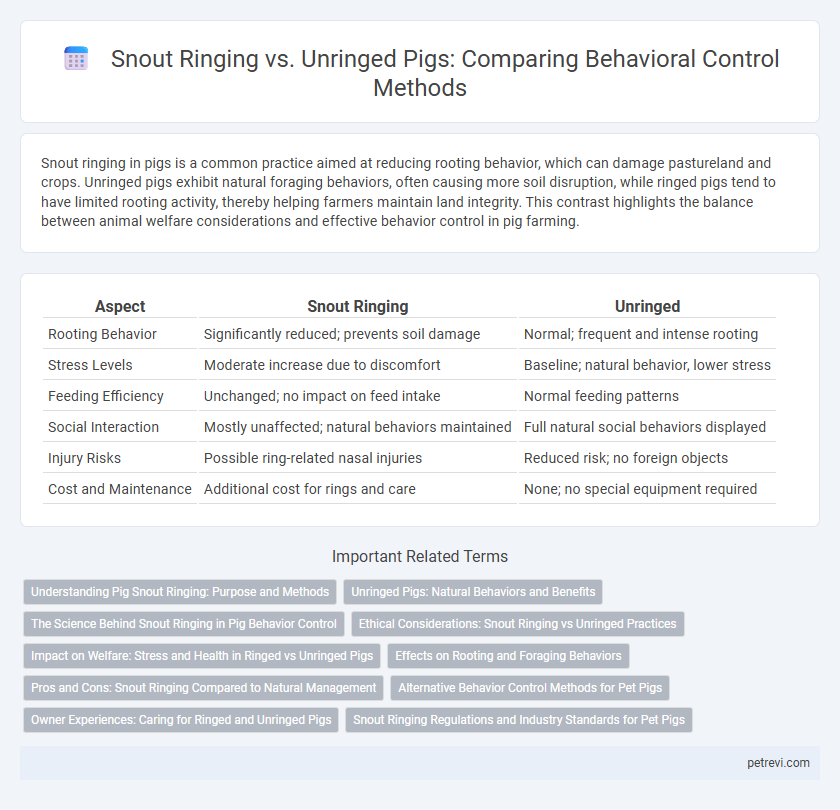Snout ringing in pigs is a common practice aimed at reducing rooting behavior, which can damage pastureland and crops. Unringed pigs exhibit natural foraging behaviors, often causing more soil disruption, while ringed pigs tend to have limited rooting activity, thereby helping farmers maintain land integrity. This contrast highlights the balance between animal welfare considerations and effective behavior control in pig farming.
Table of Comparison
| Aspect | Snout Ringing | Unringed |
|---|---|---|
| Rooting Behavior | Significantly reduced; prevents soil damage | Normal; frequent and intense rooting |
| Stress Levels | Moderate increase due to discomfort | Baseline; natural behavior, lower stress |
| Feeding Efficiency | Unchanged; no impact on feed intake | Normal feeding patterns |
| Social Interaction | Mostly unaffected; natural behaviors maintained | Full natural social behaviors displayed |
| Injury Risks | Possible ring-related nasal injuries | Reduced risk; no foreign objects |
| Cost and Maintenance | Additional cost for rings and care | None; no special equipment required |
Understanding Pig Snout Ringing: Purpose and Methods
Pig snout ringing is a behavioral control technique designed to prevent rooting, which can damage soil and infrastructure. Rings, typically made of metal or plastic, are inserted into the cartilage of the pig's snout, causing discomfort when rooting but not injuring the animal. This method balances controlling destructive behaviors while maintaining animal welfare and productivity.
Unringed Pigs: Natural Behaviors and Benefits
Unringed pigs exhibit natural rooting behaviors essential for soil aeration and pest control, promoting healthier pasture ecosystems. Without snout rings, pigs maintain normal social interactions and foraging patterns, reducing stress-related aggression and improving overall welfare. Preserving these innate behaviors supports sustainable farming practices by enhancing biodiversity and minimizing environmental impact.
The Science Behind Snout Ringing in Pig Behavior Control
Snout ringing in pigs serves as a behavioral control method by inhibiting rooting activity, which is driven by pigs' natural foraging instincts and can cause damage to pastureland. Scientific studies reveal that the placement of a snout ring disrupts sensory and motor functions in the nasal cartilage, reducing rooting intensity without affecting overall animal welfare or growth performance. This practice balances environmental conservation with maintaining pigs' natural behaviors, providing a practical approach in extensive pig farming systems.
Ethical Considerations: Snout Ringing vs Unringed Practices
Snout ringing in pigs is a controversial method used to curb rooting behavior, yet it raises significant ethical concerns due to pain and stress imposed on the animal. Unringed pigs exhibit natural rooting behaviors essential for their mental stimulation and physical health, promoting welfare through more humane treatment. Ethical husbandry emphasizes minimizing invasive measures like snout ringing, advocating for environmental enrichment as a preferable alternative to control destructive behaviors.
Impact on Welfare: Stress and Health in Ringed vs Unringed Pigs
Snout ringing in pigs significantly reduces rooting and destructive behaviors, but it is associated with increased stress indicators and potential respiratory issues due to pain and discomfort. Unringed pigs exhibit more natural foraging behaviors, contributing to better mental stimulation and overall welfare, but can cause environmental damage if not managed properly. Welfare assessments highlight the need for balancing behavioral control and health impacts, suggesting alternative enrichment strategies to minimize stress while preventing harmful rooting.
Effects on Rooting and Foraging Behaviors
Snout ringing in pigs significantly reduces rooting behavior by causing discomfort that discourages digging and soil disruption, which can be beneficial in protecting pasture integrity. Unringed pigs exhibit more natural rooting and foraging behaviors, promoting soil aeration and nutrient cycling but potentially leading to greater damage in managed landscapes. Balancing welfare concerns and environmental impact is essential when deciding between snout ringing and leaving pigs unringed for behavior control.
Pros and Cons: Snout Ringing Compared to Natural Management
Snout ringing in pigs effectively reduces rooting behavior, preventing damage to pasturelands but often causes discomfort and stress, potentially affecting overall welfare. Natural management without snout rings promotes normal pig behavior and welfare, supporting soil health through natural rooting but may result in more extensive land degradation and increased maintenance costs. Balancing welfare concerns with environmental impact is crucial when choosing between snout ringing and unringed strategies in pig behavior control.
Alternative Behavior Control Methods for Pet Pigs
Snout ringing is traditionally used to prevent rooting behavior in pigs but can cause discomfort and stress, prompting pet owners to seek alternative behavior control methods. Positive reinforcement training and environmental enrichment, such as providing designated digging areas or interactive toys, effectively reduce destructive rooting without physical restraint. Implementing consistent routines and socialization further enhances behavioral control, promoting welfare-friendly management of pet pigs.
Owner Experiences: Caring for Ringed and Unringed Pigs
Owners report that snout ringing effectively reduces rooting damage by discouraging pigs from digging, fostering easier management in confined areas. Unringed pigs exhibit more natural foraging behavior, requiring larger spaces and more enrichment to prevent destructive tendencies. Experiences highlight that while ringed pigs may show less stress in restricted environments, unringed pigs tend to have better overall welfare when allowed adequate outdoor access.
Snout Ringing Regulations and Industry Standards for Pet Pigs
Snout ringing is regulated differently across regions, with many industry standards emphasizing humane methods to prevent destructive rooting behavior in commercial pigs, but restrictions often apply for pet pigs to ensure welfare. Regulations may require veterinary supervision and limit snout ring use, promoting alternative behavior management techniques for companion pigs. Compliance with these standards reflects growing concern for ethical treatment and the promotion of natural behaviors in pet pig care.
Snout Ringing vs Unringed for Pig Behavior Control Infographic

 petrevi.com
petrevi.com